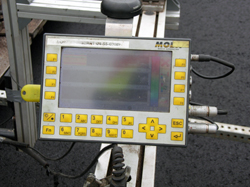TERRA E-News, January 2013 – Volume 7, Number 1
Data-driven improvements sought from innovative construction technologies
In summer 2012, the Minnesota Department of Transportation (MnDOT) used a number of innovative construction technologies on Minnesota Trunk Highway 56 (from Kenyon to West Concord) to determine which ones have the greatest potential for constructing a safe, efficient, and sustainable roadway. Many of the technologies described in the sidebar to this article also were used during another project on nearby TH 57. These tests were part of a MnDOT commitment to innovation in preserving existing infrastructure.
Major reconstruction of TH 56 was required because the existing roadway had a poor ride with significant cracking. As part of the reconstruction process, the MnDOT District 6 office in Rochester created alternate concrete and bituminous plans for bidding. Rochester Sand & Gravel (a division of Mathy Construction, a TERRA member) won the bid and elected to construct the stabilized base/bituminous pavement option.
Since completion of the construction projects, MnDOT has been conducting evaluations for each technology based on the significant amount of data collected. Each technology is being assessed for future inclusion on subsequent construction projects.
Ervin Dukatz, vice president of materials and research with Mathy Construction, said that the innovative technologies tested during the construction project serve as good tools for quality control.
“All the current rollers do provide good performance in recording where the roller has been and how many times it was there, as well as providing real-time feedback to the roller operator,” he said.
However, there is still plenty of room for further development to make these technologies even more practical and cost-effective for construction contractors.
For instance, to obtain the equipment and use it effectively, Dukatz pointed out that contractors need to factor in the time it takes to get it, the time to make it operational (e.g., retrofitting rollers), the time to train and support operators, and, of course, the money it takes to make it all happen.
In addition, the stiffness data collected currently are unique to each intelligent compaction (IC) roller on the project and have yet to be directly correlated to performance. “It’s difficult to set universal target values,” he said, “since the stiffness values measured are not calibrated to a standard that is measurable and repeatable for all rollers and manufacturer’s devices.”
Nevertheless, with further research, testing, and implementation, Dukatz foresees eventual widespread usage of these technologies in road construction, especially due to the encouragement provided by the Federal Highway Administration through the Every Day Counts (EDC) and Civil Integrated Management (CIM) initiatives.
Greg Johnson, assistant bituminous engineer with the MnDOT Office of Materials & Road Research, contributed to this article.
Related resources:


